-

人教版高中英语必修4A taste of English Humor说课稿3篇
Then I would ask them to think of a funny English or Chinese and tell it to partners. While telling stories, they can use expressions and some acting to help make the story funny. 5 minutes would be given to do this.Those stories they told there will be the material for their writing. Soletting them tell it at first is helpful. And they can make a difference between telling a funny story and writing it down. Generally speaking, it is difficult forstudents to write well because they don’t know what to write and how to write. Asking them to tell their own stories at first can help them come up with what to write.After their telling, I would invite someone to share his/her story with all of us and I would write it down on the blackboard.This example story would be used as a sample to illustrate the format of funny story. Different from a story from teacher or textbook, a story from students can obviously become a interesting material to draw students’ attention.Then I would ask the whole class to put this story into several parts. It might be a little bit difficult for them. So I would ask them to find out whether all the sentences are necessary. After delete some sentences, there are 6 sentences left behind. Then they can easily put them into three parts. After interaction with students, I would teach them the right terms for each part and conclude the format of funny story.This step is the key and difficult point in my lesson. So I mainly usetask-based teaching method in this part and the task for students was divided into several stages. With the separated difficult level, students can find there are usually three parts in writing. They can also learn to write without the unnecessary parts in the process of analyzing. And then I wouldn’t rush to tell them the right terms to them directly. Instead, I would ask them to name them by their own. A confused mind is better for acquiring knowledge.While-writing:Then I would give students 7 minutes to write down this story, without other requirements.With all the preparations in pre-writing, students’ difficulties were cleared. So it would be much easier for them to write down the story within 7 minutes. There are no other requirements because students’ first writing is actually a drafting. It would be revise and edit several times later. Writing, as a skill

人教版高中英语必修3Canada-the true north说课稿4篇
Good afternoon, teachers, It’s my great pleasure to be here sharing my lesson with you.The content of my lesson is Senior English Book 3 Unit 5 Canada —— “The true North”.I’ll be ready to begin this lesson from five parts. Analysis of the teaching material,the teaching methods,the studying methods, the teaching procedure,and Blackboard design.First, let me talk about the teaching material.Part 1 Teaching Material:This unit is about the introduction of Canada. By studying of this unit,we’ll enable the students to learn the geography, population, main cities, and natural beauty, natural resources of Canada. Through the training of the unit, it also requires students to learn some Language skills such as the expressions of position and emotions.So it plays an important part in the English teaching in this book.After studying the teaching material and analyzing the rule of children’s growing of mind,I think the teaching aims are the followings:1.Knowledge objects:(1) make the students learn some new words and phrases(2) make the students understand the content of the lesson.2.Ability objects:(1)To develop the Ss’ abilities of listening, speaking, reading and writing. Especially reading and speaking ability.(2) learn to talk about the characters of Canada in English(3)To train the Ss’ ability of working in pairs.3.Emotion objects:(1)Enable students to understand the characters of Canada..(2)Stimulate Ss to work hard to make China stronger.Part 2 Teaching Methods:I think helping students learn to master new words and phrases and improve the students’ reading and speaking ability is import and the difficult.According to the analysis of the teaching material and the import points and the difficult points,I will use the following teaching methods : question-guiding approach; fast-reading and careful reading; multi-media teaching methods; discussion

人教版高中英语必修4Women of achievement说课稿4篇
Good morning, distinguished judges:It’s my honor to talk about my teaching ideas with you. Today my topic is Women of Achievement. My presentation consists of six parts: the analysis of teaching material and student, teaching aims, key and difficult points, teaching and studying method, teaching procedures and blackboard design.First, let’s focus on the analysis of teaching material. This lesson is from New Senior English for China Student’s Book 4 Unit 1, the reading part. The main topic of the passage is the introduction of a student of Africanwildlife. After this lesson, the students will learn more information about her studying chimps in Africa, and their reading and speaking abilities can be developed as well.The next part is the analysis of students. My students are in senior high students. They have learnt English for many years, they’ve known many words and sentences, but their speaking and reading abilities are still not very good. So I will practice their speaking and reading abilities through different exercises.According to the New Standard Curriculum and the present situation, I set the teaching aims as follows: firstly, knowledge aims. Students can grasp some new words, such as worthwhile, move off. Moreover, students can understand the content of the passage and get familiar with the topic of studying chimps in wildlife. Secondly, ability aims. Students can use reading strategies such as skimming and scanning in reading process. Thirdly, emotional aims. Students can have the awareness of protecting animals and care about animals.Based on the above analysis, the key point of this lesson is to get the main idea and the detailed information from the passage; the difficult point is to talk about the wildlife protection and use reading strategies.

人教版高中英语必修3Festivals around the World说课稿3篇
Teaching plan for Unit 1 book3Good morning, teachers. It’s my great pleasure to be here because I can share my lesson with you and I can learn a lot from it. I’ll begin my lesson from the following four parts, the teaching material, the teaching methods, the studying methods and the teaching procedure.Firstly, let me talk about the teaching material. The content of my lesson is the reading passage festivals and celebrations of Unit 1 Festivals around the world. This passage is about festivals and celebrations. By studying this passage, we’ll enable the students to know that festivals exit everywhere, and many of festivals in different countries celebrate similar ideas. As we all know, the reading passage is the center of each unit. If the Ss can learn it well, it will be helpful to make the Ss learn the rest of this unit.After studying the teaching material, I think the teaching aims are as the followings:1. Knowledge aims:(1) The Ss can master the usage of the important words andexpressions.(2)The Ss can use the __________________ (grammar) in the proper situation.Make students know about the festivals all over the world and the detail of the festivals, such as origin, content, and the date of the holiday festivals.2. Ability aims:(1) Students can talk about festivals and celebrations in English(2) To improve the student’s reading ability, especially their skimming and scanning ability.3. Emotion aims:Make the Ss know about the foreign festivals, and respect other countries’ custom.Next, let’s come to the important points and the difficult points.The important point is how to make the Ss understand the text better and the difficult point is how can they talk about it. secondly, Teaching Methods:1. task-based Language Teaching2. Computer assisted language teaching.3. question-and–answer methodThirdly, Studying Methods:

人教版高中英语必修3Healthy Eating说课稿4篇
Language learning needs a context, which can help the learners to understand the language and then can product comprehensible output, so computer has the advantages to make the materials attractive.Part 3 Learning MethodsTask-based, self-dependent and cooperative learningPart 4 Teaching ProcedureStep One Lead-in“Interest is the best teacher.” Therefore, at the very beginning of the class, I should spark the students’ mind to focus on the centre topic “the band”. I’ll show some pictures of food to attract their attention and then bring some questions.Question:What kind of food they like?What should go into a good meal?The answers must relate to the diet. After this, the students will be eager to know something about a balance diet and this is the very time to naturally lead the class into Step 2Step 2 Reading for information: skimming and scanning In this step, I use Task-based Language Teaching method, which can give students a clear and specific purpose while skimming and scanning the context.Task 1 General ideaThe students will be asked to just glance at the title and the pictures of the passage, and then guess what they will read in the text. And they’ll be divided into groups of four to have a discussion.The purpose is to inspire the students to read actively, not passively. In addition, the task is to develop the students’ reading skill by making prediction and to encourage the students to express their thoughts in English and cooperate with each other.Task 2 Main idea of each paragraphCooperative learning can raise the students’ interest and create an atmosphere of achievement. Based on this theory, I divide the whole class into 4 groups to skim the whole text and get the main idea of each paragraph.

人教版高中英语必修4Working The Land说课稿3篇
Knowledge objectives:(1) to make Ss grasp the usage of words, expressions and sentence structures: statistics, struggle, thanks to, rid of, some patterns for persuasion, the “ing” form as subject and object;(2)to use learnt knowledge to persuade sb.Ability objectives:(1) to develop Ss’ reading skills(skimming, scanning, word guessing);(2) to improve Ss’ speaking, communicating and cooperating skills.Emotional objectives:to make Ss know the contribution of Yuan,and learn his spirit and his simple life time.Teaching important and difficult points:(1) some words, expressions and sentence structures mentioned above;(2)the content of the text;(3)training their reading and speaking skills.Teaching methods: CLT, TBLT,QT.Learning strategies: CLS, QLS, TBLS.Teaching procedures:Step 1 lead-in: (1) teacher plays a piece of recent news from CCTV about the harvest of the super hybrid rice, and ask students whether they know Yuan or not, and talk about him and his contribution.(2)Brain storm: let Ss describe Yuan in their minds including his appearance, his living condition and so on.Step 2 fast reading tasks:(1)teacher introduces Yuan and super hybrid rice(2)make Ss read the text as fast as possible with questions. Such as: what’s the general ideaof this passage? What’s Yuan’ dream? (skimming and scanning skill)Step 3 intensive reading tasks(1)let Ss read the text silently, find topic sentence of each paragraph and draw the difficult sentences and the knowledge what they don’t understand.(words guessing)(2)teacher and Ss talk about the important words, expressions and sentences together, and ask Ss to retell the content of the text.(summarizing and paraphrasing)(3)teacher summarize this part.(4) read again following the courseware.

人教版高中英语必修3The million pound bank note说课稿3篇
在接下来的细读环节,我套用了高考对阅读理解的考查方式设置了5个问题,分别为三个推理判断题,一个细节题和一个主旨大意题。学生需要对文章的内容进行分析、归纳、推理、猜测等高级思维活动才能做出正确的回答。【设计意图】这一过程是对学生进行细读的训练,培养学生获取特定信息和挖掘文章深层次信息的能力。第三环节:Intensive-reading (精读) 15′第三个环节精读,既是最重要的环节,也是突破本课重难点的关键。首先,让学生思考剧本中人物看到百万英镑前后的态度发生了怎样的变化。其次,让学生仔细阅读文章,找出可以表现人物态度变化的具体的语言和动作。最后,让学生总结人物的态度发生变化的根本原因是什么,从而引出Money Talks, 供学生思考。【设计意图】通过一系列的活动培养学生学习从人物的语言和动作探究人物的心理,使学生进一步体会戏剧语言的魅力,从而对文章背后所反映的社会问题进行思考,也为下一步的讨论环节做好铺垫。

人教版高中英语必修5First aid说课稿6篇
In this class, I have 3 teaching aims, that is, knowledge aims, ability aims and emotion aims.1) Knowledge-Teach students new words and expressions, such as temporary, bleed,sprain choke, first aid, fall ill and so on.-Enable students to have a better understanding for some basic knowledge of first aid.2) Ability-Train students’ speaking, reading and writing abilities by different teaching activities, such as skimming, comprehending, team work, role play, retelling and writing.-Develop students’ reading strategy on how to move general idea to specific information.3) Emotion-Promote students’ awareness of giving first aid.- Cultivate students’ creativities.Then let’s come to my teaching methods and activities.III. Teaching methods and activities:To achieve different teaching aims, various kinds of teaching methods and activities will be adopted throughout this period, such as TBL (task-based learning), skimming, team work, brainstorm and others, which can offer students opportunities to fulfill tasks in which they can use language to achieve a specific outcome.IV. Teaching aids:Computer and blackboardV. Teaching important points:1) Make students have a clear mind for the structure of the text.2) Help students understand the theme of the text.VI. Teaching difficulties:1) So many new words may affect students’ understanding.2) How to get students to know about the functions of the skin and thecauses, characteristics and treatments for different degree burns,and the knowledge about giving first aid. VII. Blackboard design:

人教版高中英语必修5Great scientists说课稿4篇
通过写文章梗概,培养学生综合运用语言的能力,学习用恰当的英语描述科学家的故事。这是本课的教学难点。教师可以使用完形填空的方式来帮助学生整理语篇,从而来降低难度。本课的教学重点的突破方法是:在阅读前,让学生初步了解得出科学观点所需要的基本程序,从而轻松而自然地导入文章的阅读;在阅读过程中,由易到难设计快速阅读和精读的问题,层层推进各种阅读活动,让学生对阅读内容从整体感知到细节理解,最后深层读懂整篇文章,同时加强阅读策略的指导,让每个学生都主动参与课堂教学活动,最终达到提高阅读能力的目的。Step 4 Post-readingGroup Activities四人小组共同合作,在老师的适当指导下,就以下2个问题展开讨论,让学生就所知、所学、所感和所想融入话题,然后抽若干同学代表作小组发言。1. What do you think about John Snow, and what should we learn from him?2. Cholera was 19th century disease, which two diseases are similar to cholera today? Why?

人教版高中英语必修5Making the news说课稿4篇
今天我们来介绍一下必修五第四单元的授课方式。这个单元的题目是Making the news。应该是学生比较感兴趣的话题,学生往往对新闻工作充满好奇,所以我们可以利用这个机会多设计一些师生互动和学生互动,来激发起学习的积极性,提高学习效率。同时我们可以利用这个单元不仅帮助学生掌握语言知识,培养语言能力,同时让其了解新闻工作的重要性,培养起社会智能感。这个单元分为六个课时,它的教学目标是这样的:语言目标是掌握词汇表中的常用单词和短语,掌握倒装句的一些基本用法。 技能目标是能初步掌握约会的基本句型并在真实的场景下正确运用。新闻报道类文章的写作技能。采访的基本规范和沟通技能。情感目标是对新闻报道的客观性和真实性有更好的理解。对新闻记者的职业有更深入的了解,并能体会其工作的重要性。下面我们来介绍一下第一课时的授课方式,第一课的教学目标是这样的第一课时的教学目标语言目标:单词:Occupation, journalist, editor, photographer, curious, personality, enthusiasm

人教版高中英语必修5The United Kingdom说课稿4篇
Teaching Aims:Knowledge 1. Get the students to learn the useful new words and expressions in this section. Aims:2. Let the students learn about how the UK was formed and the four groups of invaders.1. Develop students’ reading ability and let them learn different Ability reading skills. Aims:2. Enable students to learn to talk about the United Kingdom and the Union Jack Emotional 1. Let students know more about the UK2. Develop students’ sense of cooperative learning Aims:Teaching Important Points:1. Let the students learn about the countries of the United Kingdom and the Union Jack2. Get the students to read the passage and know about how the UK was formed and the four groups of invaders.3. Have the students learn different reading skills.Teaching Difficult Ponts:1. Develop students’ reading ability.2. Enable students to talk about the United Kingdom and the Union Jack.3. Let students learn how the UK was formed geographically and historically.Teaching Methods:Showing pictures, asking, exercising, listening, reading etc.Teaching Aids:A computer,a projector and a blackboard.Teaching Procedures: 1) Show a map of the world, ask students the following questions:Where is the UK?What’s the full name of the UK?2) Ask the students work in pairs to do the quiz on Page 9.Do you want to test how many things you know about the United Kingdom? Let’s have a small test.Using the map on P9, students answer the following questions:?How many countries does the UK consist of? What are they??England is divided into three main areas. Do you know what they are? 1) Scanning (10Minutes )Let the students hold the questions asked in pre-reading and read the passagequickly and then let them do the following exercise.Join lines to the right answer.

人教版高中英语必修1English around the world说课稿
(3)v. 给:提出;展现,显现present sb. with sth. ; present sth. to sb. 把. . 交给;颁发;授予present sth. (for sth. )/present sth. to sb. e. g. Om his birthday, his friends presented him a collection of stamps. 在他生日时,他的朋友们送给他一套邮票作为礼物。The sword was presented by the family to the museum. 这家人把宝剑捐赠给了博物馆。The committee will present the final report to Parliament in June. 委员会将在六月向议会提交最后的报告。You need to present yourself better. 你需要更善于展现自己。It is essential that we present a united front. 至关重要的是我们要表现得更加团结。Step 4 ConsolidationT:Now that we have got a general idea of these words and phrases. Lets make up some sentences using them to master them. Suggested sentences:1. Your duties include typing letters and answering the telephone. 2. It is one of the greatest roles that she has played. 3. A large number of people have applied for the job. 4. The number of the panda is declining. 5. I'11 go there, even if I have to walk. 6. He came up to me to ask for a light. 7. The novel is about a family who can't communicate with each other. 8. He based his plan on interests of most people. 9. Why doesn't he make use of his singing talent?Step 5 Summary and homeworkT:Today we dealt with several new words and phrases. After class I hope that youcan read them again and again to keep them in mind. That's all for today. You aredismissed.
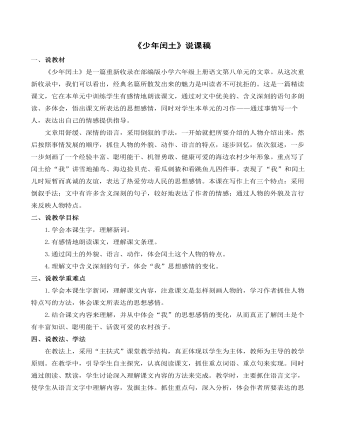
《少年闰土》说课稿
说教学目标? 1.学会本课生字,理解新词。?2.有感情地朗读课文,理解课文条理。? 3.通过闰土的外貌、语言、动作,体会闰土这个人物的特点。4.理解文中含义深刻的句子,体会“我”思想感情的变化。?三、说教学重难点? 1.学会本课生字新词,理解课文内容,注意课文是怎样刻画人物的,学习作者抓住人物特点写的方法,体会课文所表达的思想感情。?2.结合课文内容来理解,并从中体会“我”的思想感情的变化,从而真正了解闰土是个有丰富知识、聪明能干、活泼可爱的农村孩子。四、说教法、学法在教法上,采用“主扶式”课堂教学结构,真正体现以学生为主体,教师为主导的教学原则。在教学中,引导学生自主探究,认真阅读课文,抓住重点词语、重点句来实现。同时通过朗读、默读,学生讨论深入理解课文内容的方法来完成。教学时,主要抓住语言文字,使学生从语言文字中理解内容,发掘主体。抓住重点句,深入分析,体会作者所要表达的思想感情,做到重点突出。
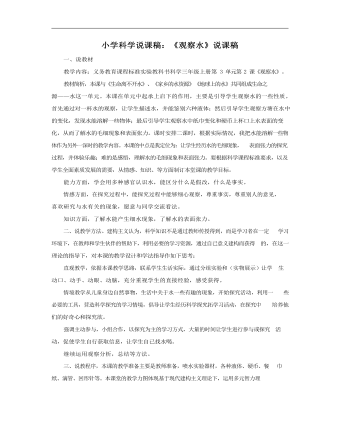
说课稿科学三年级上册《观察水》
二、说教学方法。建构主义认为,科学知识不是通过教师传授得到,而是学习者在一定 学习环境下,在教师和学生伙伴的帮助下,利用必要的学习资源,通过自已意义建构而获得 的,在这一理论的指导下,对本课的教学设计和学法指导作如下思考:直观教学,依据本课教学思路,联系学生生活实际,通过分组实验和(实物展示)让学 生动口、动手、动眼、动脑,充分重视学生的直接经验,感受获得。情境教学从儿童身边自然事物,生活中关于水一些有趣的现象,开始探究活动,利用一 些必要的工具,营造科学探究的学习情境,倡导让学生经历科学探究拓学习活动,在探究中 培养他们的好奇心和探究欲。
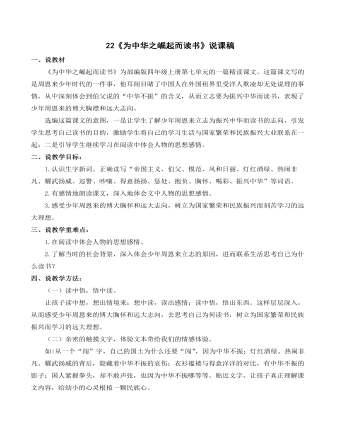
《为中华之崛起而读书》说课稿
通过角色朗读,让学生入情入境,进入人物的内心,感受周恩来第一次听到“中华不振”时疑惑的心理,进而理解周恩来后来为什么会不听伯父的话,闯入租界,为第二部分的教学做下铺垫。
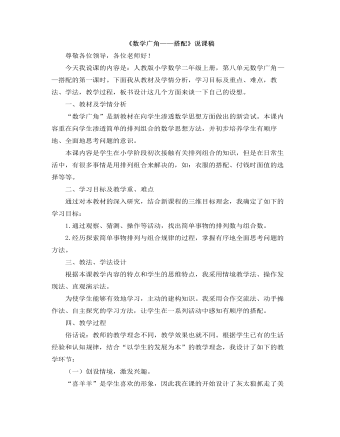
小学数学人教版二年级上册《数学广角——搭配》说课稿
一、教材及学情分析“数学广角”是新教材在向学生渗透数学思想方面做出的新尝试。本课内容重在向学生渗透简单的排列组合的数学思想方法,并初步培养学生有顺序地、全面地思考问题的意识。本课内容是学生在小学阶段初次接触有关排列组合的知识,但是在日常生活中,有很多事情是用排列组合来解决的,如:衣服的搭配、付钱时面值的选择等等。二、学习目标及教学重、难点通过对本教材的深入研究,结合新课程的三维目标理念,我确定了如下的学习目标:1.通过观察、猜测、操作等活动,找出简单事物的排列数与组合数。2.经历探索简单事物排列与组合规律的过程,掌握有序地全面思考问题的方法。三、教法、学法设计根据本课教学内容的特点和学生的思维特点,我采用情境教学法、操作发现法、直观演示法。为使学生能够有效地学习,主动的建构知识。我采用合作交流法、动手操作法、自主探究的学习方法,让学生在一系列活动中感知有顺序的搭配。
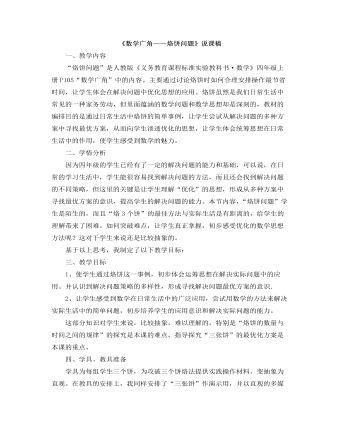
小学数学人教版四年级上册《数学广角——烙饼问题》说课稿
第一个板块是“脑筋急转弯”,激发学习兴趣。目的有两个:一是拉近与学生的距离,二是为本节课做铺垫。第二板块是自主探究,优化策略。这一部分内容通过“操作感悟——抽象内化——巩固应用”三个片段,使学生在教师的点拨引导下,沿以下四个步骤:“一张和两张饼的烙法(基础)→三张饼的最佳烙法(难点)→双数饼、单数饼的烙法(提升)→最佳方案、双数饼:两张两张烙;单数饼:两张两张烙+最后3张饼交叉烙(优化)进行探究。1、探索烙3张饼的最少时间是本节课的重点也是难点,优化的数学思想只能是“渗透”而不能“明透”,也就是说只能让学生在潜移默化的过程中理解,而不能仅仅靠传授。因此,本课中蓄势----为探索最佳方法打基础的方法,自认为运用得恰到好处。例如,围绕“烙2张饼最少要花6分,为什么烙1张饼与2张饼所用的时间一样多呢?你们是怎么想的?”这个问题,让学生体会烙2张饼是用足了空间,而烙1张饼浪费了空间和时间,为探索烙3张饼埋下了伏笔。

小学数学人教版四年级上册《数学广角——合理安排时间》说课稿
(五)课前准备: 1、铺垫:让学生和家长一起收集历代有关合理安排的故事。 2、教具准备:圆形卡片、工序卡片、记录表格和多媒体课件等。 学具准备:让学生以小组为单位制作好图形卡片和工序卡片。 二、说教法和学法 在教学方法上,为了使学生能轻松、愉快地理解优化思想,根据学生的认知特点和规律,在本课的设计中,我使用了演示法和实验法,通过课件的情境演示和实物的操作为学生创设情境,让学生独立思考,然后动手操作,互相交流,最后找出最优方案的方式组织教学。 在学法方面,我设计了一系列贴近学生生活实际和年龄特点的教学活动,在这些活动中,着重以引导学生运用自主探究、合作探究两种学习方式交替学习,让他们真正以课堂的身份参与全程。并培养他们收集数据和分析处理数据的能力。
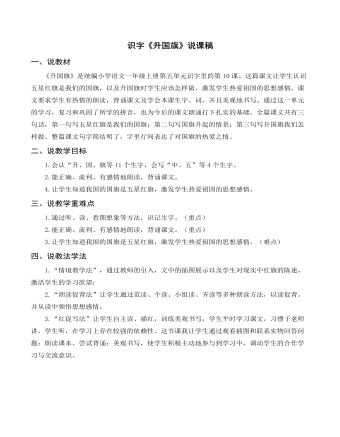
部编人教版一年级上册识字《升国旗》说课稿
一、说教材《升国旗》是统编小学语文一年级上册第五单元识字里的第10课。这篇课文让学生认识五星红旗是我们的国旗,以及升国旗时学生应该怎样做,激发学生热爱祖国的思想感情。课文要求学生有热情的朗读,背诵课文及学会本课生字、词,并且美观地书写。通过这一单元的学习,复习和巩固了所学的拼音,也为今后的课文朗诵打下扎实的基础。全篇课文共有三句话,第一句写五星红旗是我们的国旗;第二句写国旗升起的情景;第三句写升国旗我们怎样做。整篇课文句字简结明了,字里行间表达了对国旗的热爱之情。二、说教学目标1.会认“升、国、旗等11个生字,会写“中、五”等4个生字。2.能正确、流利、有感情地朗读,背诵课文。4.让学生知道我国的国旗是五星红旗,激发学生热爱祖国的思想感情。
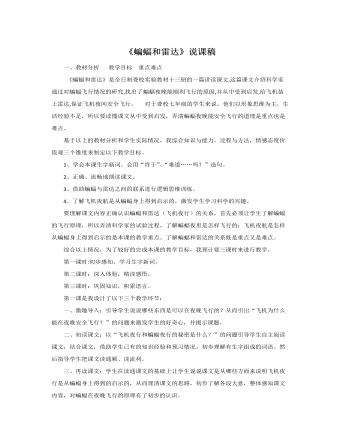
(新)部编人教版四年级上册《 蝙蝠和雷达》说课稿
一、激趣导入:引导学生说说哪些东西是可以在夜晚飞行的?从而引出“飞机为什么能在夜晚安全飞行?”的问题来激发学生的好奇心,并揭示课题。二、初读课文:以“飞机夜行和蝙蝠夜行的秘密是什么?”的问题引导学生自主阅读课文,结合课文,借助学生已有的知识经验和预习情况,初步理解有生字组成的词语。然后指导学生把课文读通顺、读流利。三、再读课文:学生在读通课文的基础上让学生说说课文是从哪些方面来说明飞机夜行是从蝙蝠身上得到的启示的,从而理清课文的思路,初步了解各段大意,整体感知课文内容,对蝙蝠在夜晚飞行的原理有了初步的认识。接下来我重点讲讲第二课时的教学设计。这一课的 教学中,我将以设疑悬疑──悟疑解疑──创造性思维训练,这种教学思路引导下,使学生充分发挥自己的主体作用,学生的积极性、主动性得到了充分的施展。学生不仅读懂了课文,认识也逐步加深。通过以下几个教学环节来完成教学任务。